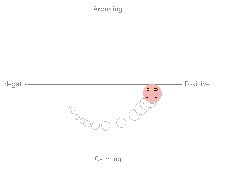Translations:Bisherige "continuous response" - Systeme/6/en
EMuJoy

EMuJoy is the abbreviation for the interface Emotion measurement while listening to Music using a Joystick. The software was developed in 2007 by Frederik Nagel and is a further development of the ESL. EMuJoy offers the possibility to use both acoustic and visual stimuli or both at the same time. Pictures can be shown in a slideshow with a certain time each, with or without pauses in between. For movies, images and sound can also be shown separately (Nagel 2007, p. 35f.). The 2DES takes up the whole screen, can be operated with joystick or mouse and offers a worm like the Feeltrace as optional visualization. Instead of the visualization with colors, a smiley in place of the mouse pointer, which adjusts its facial expression to the position in the coordinate system, provides user feedback. Along the valence axis, the corner of the mouth changes and the eye size increases with increasing activity. Chills are additionally captured via mouse click (Kopiez et al. 2011, pp. 138-141). Further advantages of EMuJoy compared to its predecessors are platform independence, since the program is Java-based, and control via the Internet, so that test subjects can participate in examinations at home in front of their own computers. In addition, there is a remote control, so that starting, stopping as well as selecting the stimuli is made possible during the course of the experiment (Nagel 2007, p. 33f.). Nagel uses a sampling rate of 1/50ms, so that the data can be evaluated up to 10 Hz. A high sampling rate is advantageous for the synchronization of stimulus and the recorded data. One might think that since emotions change far more slowly, such a high sampling rate would be unnecessary, but nevertheless, self-reports can change very quickly and one might lose valuable data, e.g., the fast path from one corner to the other (Nagel 2007, p. 32f.).